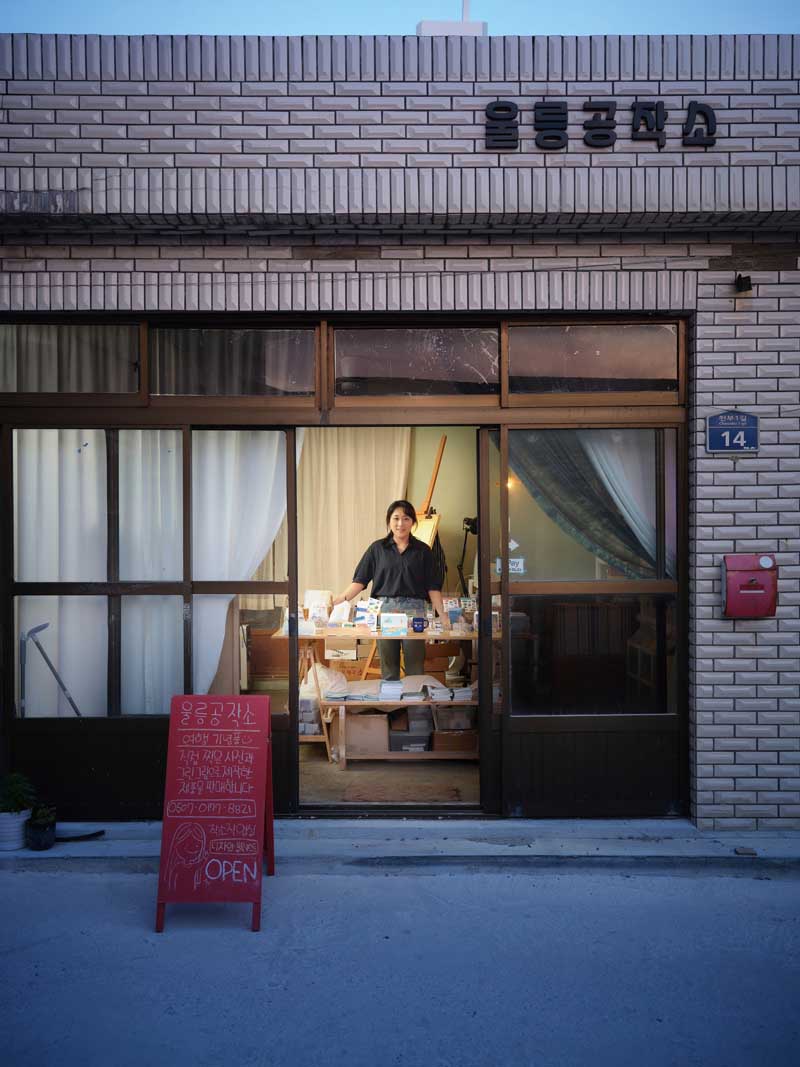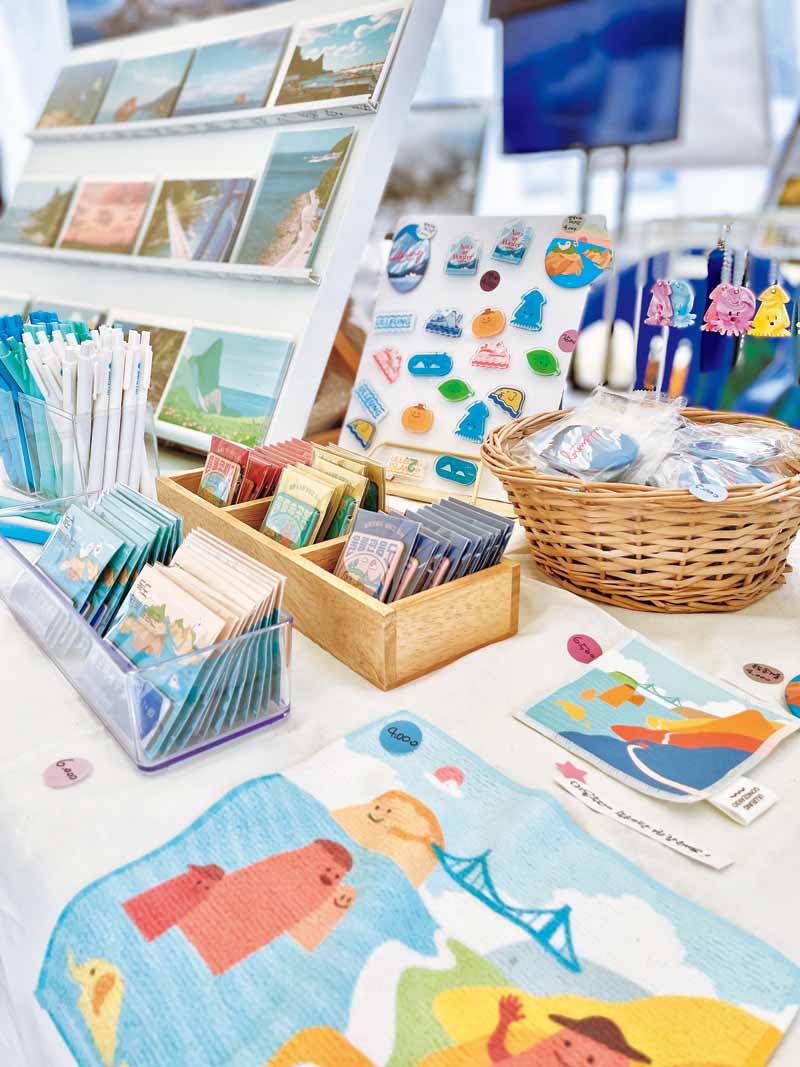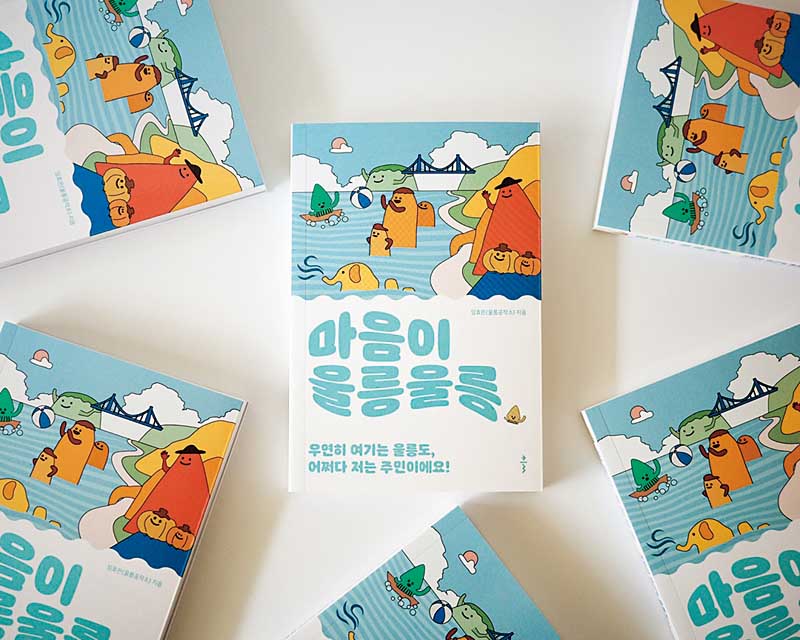Tired of the fast pace and high pressure of city life, more and more young Koreans are moving to rural villages and coastal towns. They aren’t necessarily interested in farming or fishing. They’re seeking a fresh start — a new challenge that might lead them back to happiness. Lim Hyo-eun, who has been living on Ulleungdo for over seven years, is one of those who made the move.

For Lim Hyo-eun, once an ordinary office worker in Seoul, Ulleungdo was a turning point in life. Captivated by the scenery and people, she moved to the island and now runs a souvenir shop there.
© Studio Kenn
Tucked away near Cheonbu Port at the northeastern tip of Ulleungdo is a charming little shop called Ulleung Gongzakso. Though small, it has an outsized personality, much like its owner, Lim Hyo-eun. A designer by training, Lim creates and sells mugs, tote bags, magnets, and keyrings — all inspired by the island’s natural beauty and local culture. Before her arrival, visitors to the island couldn’t find even a simple postcard to send home. Now, they have their pick of thoughtful, beautifully designed souvenirs that capture the locale’s spirit. In fact, some people come to Ulleungdo specifically after discovering Lim on social media or reading her 2024 book My Heart Goes Ulleung Ulleung. In this way, her work has sparked curiosity about a place that once seemed remote and out of reach.
Lim studied design in college and worked in Seoul after graduating. But by 2018, she was feeling burnt out by the daily grind. That’s when she stumbled upon a program offering a one-month stay on Ulleungdo. For someone craving escape, it felt like the universe had answered. The program even offered free lodging. How could she say no?
Most participants left straight after; some left just two weeks into the program, unable to adjust to the unfamiliar rhythm of island life. For many, Ulleungdo’s slower pace and higher living costs were simply too much. But to Lim, the island offered space to breathe, think, and create. She decided to stay and start over. Today, she wears many hats: designer, photographer, essayist, and influencer. Through her work, she introduces Ulleungdo to a wide audience, offering a glimpse into a different way of living.
What prompted you to settle on the island?
At the time, I felt that if I didn’t do it now, I might never have the courage. The idea of isolating myself on a remote island seemed strangely exciting. If someone had tried to push me into living on Ulleungdo, I probably would have refused. But because it was entirely my choice, it felt like an adventure worth taking.
What attracted you to the idea?
It’s been seven years since I first came here, but I still remember that day like it was yesterday. Just getting here was an ordeal. The ferry was delayed, and the ride was so rough. I’d stayed up all night, worried about getting seasick, so by the time I boarded the boat, I was completely out of it. I wandered around half-asleep, not knowing where I was or what I was doing. But then the sunset came, and it was stunning. That moment is still etched in my memory.
The coastal road that circles Ulleungdo is only about 46 kilometers long, roughly the distance of a full marathon. But this small island is full of unique landforms that are hard to find anywhere else in Korea. It almost feels like a foreign country, except everyone speaks Korean. There’s something truly otherworldly about it. With its volcanic terrain, heavy snowfall, and mild temperature swings throughout the year, Ulleungdo is often featured in Korean geography textbooks. I’ve loved geography since I was a child, so I found the island instantly and deeply fascinating.
What has life on Ulleungdo been like?
It’s a beautiful yet rugged place. Ulleungdo was officially recognized as a habitable island in the 1880s. Around fifty settlers from the mainland came here and carved out a life for themselves, turning the steep mountainsides into livable land. I can’t fully imagine what they must have felt back then. But even as they struggled to cultivate the dry soil and endured backbreaking labor, they must have recognized the island’s extraordinary beauty.
The scenery might seem the same every day, but if you look closely, it never repeats itself. The seasons arrive in their own way, and the color of the evening sky changes daily. Observing those subtle shifts, one day at a time, is how I’ve passed all these years. To be so deeply immersed in something that you lose track of time — that’s a rare kind of luck. For me, Ulleungdo is exactly that: a place I can fully lose myself in.
What extra efforts do you make living here?
Today, I baked a baguette for the first time in my life. I’ve never really been into bread — not eating it, and certainly not baking it. But the thought of not being able to find good bread on Ulleungdo made me feel a little wistful, so I decided to try making it myself. Surprisingly, it turned out well, good enough that I plan to make it again from time to time. Since last year, I’ve also been growing vegetables like eggplant, red peppers, and lettuce in my yard. Little by little, I’m finding things that I can do on my own.
My heart also feels lighter. When I lived in the city, I was afraid of change. These days, everything is quickly being replaced by AI and digital technology. But after settling on the island and learning to do more things on my own, change no longer scares me. Now, I feel like I can take on anything. Living solely off my own efforts is hard, but in a joyful way.
How did Ulleung Gongzakso come about?
After settling on Ulleungdo, my first project was the East Film Festival, a small local event that I helped plan, design, and run. Since the island doesn’t have a movie theater, residents have to take a ferry to another city just to watch a film. That felt like such a shame, so in 2019, we launched the festival to bring cinema to the island. Over time, I got involved in other projects, too. I ran a two-week stay program for visitors, opened a guesthouse, and started sharing life on Ulleungdo through a webtoon on my social media channels.
Then in 2023, I opened Ulleung Gongzakso, a souvenir shop. The idea came from my own experience. I remembered wanting to buy something to remember my trip by, only to find that there weren’t any proper souvenirs available. So, I decided to make them myself. I started small, creating postcards using photos I had taken. It seemed sad that Ulleungdo didn’t have something as basic as a postcard, which is so common at other tourist destinations. From there, I began designing character illustrations of iconic Ulleungdo landmarks like Nari Basin, Songgotbong, and Gongam. Those illustrations became the basis for an expanding line of design products.

Lim creates souvenirs featuring illustrations of Ulleungdo’s landmarks and local specialties. Postcards based on her own photographs of the island are also popular.
© Lim Hyo-eun
Today, the shop sells a variety of items: everyday goods like mugs and tote bags, and even eco-friendly products like recycled keyrings made from bottle caps. It’s located in Cheonbu-ri, which isn’t a major tourist area. Still, many people seek it out after reading my book or following my social media. Some visitors have even asked for my autograph.
The more people visit Ulleungdo, the more I have to do. I’ve been collaborating with North Gyeongsang Province and Ulleung County to develop tourism content. Recently, I created a promotional video and posters for Nari Village, and helped produce social media material for Ulleung County’s tourism office.
What support is there for the local community?
Ulleungdo is one of the regions in Korea facing serious population decline. It’s a tough reality, but there are people here who genuinely care and are working together to make things better. Until 2023, I was part of Ulleung County’s Youth Policy Group. We met regularly to talk about the challenges of living on the island and ideas for improvement. At the same time, I’ve continued sharing my own story, hoping others will take an interest in Ulleungdo.
I’ve also found a strong sense of community among the other young people who have moved here. Some run freediving shops, cafés, or guesthouses, bringing fresh energy to the island. And there are some who have come to try island life for a year. One of my neighbors now is someone who visited Ulleung Gongzakso last year. She told me then how much she wanted to live here — and now, she really does.

Published in 2024, Lim’s collection of essays captures the ups and downs of her journey, from quitting her job to settling on Ulleungdo.
© Lim Hyo-eun
What local issues are most important to you?
Housing and healthcare, without a doubt. Ulleungdo’s housing supply is much lower than the national average. Because it’s an island, construction is expensive and complicated, and it’s hard to find decent places to live. I’ve seen people give up on settling here simply because they couldn’t find a home. If we had more affordable and comfortable housing, I’m sure more people would choose to stay. We also need more medical professionals, especially for families or anyone thinking of living here long-term.
Any words for those thinking of visiting Ulleungdo?
There’s a phrase I always keep in mind: Live as if you’re on a train with no set destination. It’s okay to hop off the train for a bit. Life keeps going. Try taking a slower train. Try staying here on Ulleungdo. Sometimes, it’s these small, spontaneous choices that make life feel fuller and richer.